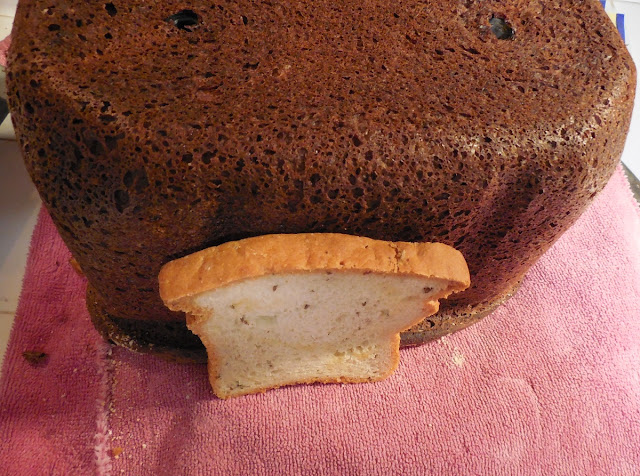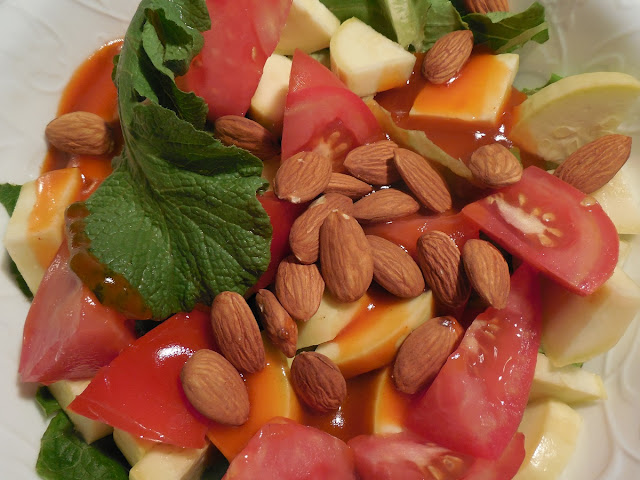The Great Gluten Free Bread Machine Experiment - Part 7
 |
| Say goodbye to itty-bitty bread slices. |
Another experimental recipe today, part of the learning curve for a bread machine. Gluten free, no diary, high fiber bread. I brought up the hydration a whole lot and increased the baking time accordingly. I added the refinement of a baking alarm after the normal bake was complete, to tell me exactly how long I have to bake it. This recipe is about the limit in how many cups of flour you can add to a 3 lb capacity machine, about 8 cups if you include the flax, chia and collagen in the flour calculation!
There is no psyllium powder in this recipe so if you're sensitive to that, need to stay psyllium free, then this is a good option. The top did rise, but it formed a valley soon after, probably due to me messing with it too much. The dough was more like batter and when it rose it was easy to lose air from it by just bumping the machine a bit. I wanted to try just chia and flax though, to see how it works without psyllium.
I was concerned that the top wouldn't brown, so I sprinkled a half teaspoon of flour on the top. That really helped me tell when the crust was cooked. I recommend that technique, especially if you don't have a thermometer. After baking the crust looked crunchy and full of delightful texture.
The crumb, or interior, was a bit too moist for my taste. I've read before that people like a "custardy" texture in bread, but I don't think this is what they meant. The flavor is good and it toasts if you use the "toast twice on low" method. It's a bit too breakable for use as a serious sandwich bread, but it's a nice side dish bread.
I definitely prefer the psyllium husk version, but I suspect another issue is the collagen. Every bread recipe I've tried that includes it turns out a bit gooey. So unless you're trying to soften up a dry bread, I'd leave it out. Bone broth is a better way to get your daily collagen.
I've changed the terminology from "Gluten Free Sponge" to "Gluten Free Soaker" for the initial gel formation. I think it's a better description. In the future there may be one or two soakers used, one to gelatinize some starches, and another to form a natural gel (such as those based on flax, chia or psyllium usually). I also plan to use some sprouted grains and beans which I hope will have a very good effect.
Multigrain Bread Machine Experiment 7
Whole wheat cycle 3 lbs dark crust + 45 min baking cycle (207 *F baking alarm)
For oven baking: the equivalent is baking at 350*F for approximately 1 hour 45 minutes.
100g ground flax seeds 2/3 cup
50g chia seeds 1/4 cup
40g collagen 1/4 cup
---- 190g "GF soaker" flours total, about 1 1/3 cup
------------% soaker flour: 22% (of total flour)
115g coconut flour 1 + 1/3 cups
250g Namaste flour 2 cups
150g almond flour 1 + 1/2 cups
150g ground buckwheat 1 + 3/4 cups
---- 665g total dry flours, about 6 2/3 cups
---------- 855g total all flours
15g salt
14g 2 packets Instant Yeast, mixed into dry flours
70g sugar
---- these don't count toward liquid or flour
150g water 2/3 cup , heated in microwave 30 sec, to mix with sugar
690g water, 3 cups, to mix with "GF soaker" flours
200g eggs 4 large
70g oil 1/4 cup
20g vinegar 2-3 tsp
---- 1130g all liquids
Hydration: 132% !!! (I can hear baking pans falling to the ground all over the Midwest.)
I pushed the hydration all the way to 169% which is close to the hydration of a "levain" but the result is longer and longer baking time without any visible benefit. It doesn't ruin the bread but there's not much point in it either.
Grind flours that need it (flax, buckwheat)
Measure and combine flours, with salt and yeast.
Measure and combine soaker ingredients. Add 690g warmed water (about 110*F) and mix very well. You may need to use a food processor if it clumps up. Beat some air into it.
Beat eggs, oil and vinegar together.
Warm the water for 30 sec in microwave. This is to hot for yeast, but it will cool when it's mixed with the other ingredients. For instance, in this recipe, you don't need to warm the eggs. When the liquids mix together, they will be just lukewarm.
Assemble the paddles in the bread machine pan. To avoid spills, fill the pan with all ingredients except 1/2 of the flour mixture while it's out of the machine.
Start the cycle and add the rest of the flour in batches over the next 5 minutes. When needed, help the machine to mix. Once the bread is mixed, this recipe doesn't have many other problems, except baking time may need to be extended.
Use a thermometer with an alarm for best results, it may take a long time to get the bread up to 205*F or higher.
That's all for today, please let me know how it turns out for you!
Bread Machine Baking Series
PDF Printout Recipe for 2 Lb Rice/Buckwheat Sandwich Bread https://nixgluten.blogspot.com/2020/10/rice-and-buckwheat-bread-recipe-gluten.html
Part 1 Raisin Bread https://nixgluten.blogspot.com/2019/10/the-great-gluten-free-bread-machine.html
Part 2 Airy Fluffy Gluten Free Bread https://nixgluten.blogspot.com/2019/10/the-great-gluten-free-bread-machine_29.html
Part 3 (Failed, lessons learned) Cinnamon Raisin Bread https://nixgluten.blogspot.com/2019/10/the-great-gluten-free-bread-machine_31.html
Part 4 High Fiber Bread https://nixgluten.blogspot.com/2019/11/the-great-gluten-free-bread-machine.html
Part 5 Stand Mixer Sandwich Bread https://nixgluten.blogspot.com/2019/11/substantial-sandwich-bread-recipe-part-5.html
Part 6 Oat Cinnamon Raisin Bread https://nixgluten.blogspot.com/2019/11/the-great-gluten-free-bread-machine_10.html
Part 7 Largest Loaf 3 Lb Machine bread https://nixgluten.blogspot.com/2019/11/the-great-gluten-free-bread-machine_12.html
Final Recipe Rice Buckwheat Bread https://nixgluten.blogspot.com/2020/02/gluten-free-whole-grain-rice-buckwheat.html
Bread Mix, Bob's Red Mill https://nixgluten.blogspot.com/2021/05/product-review-bobs-red-mill-homemade.html






